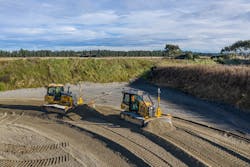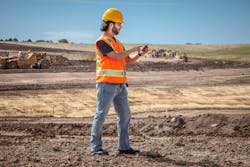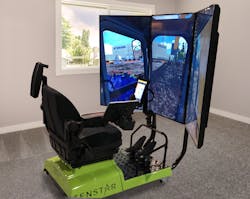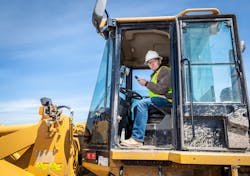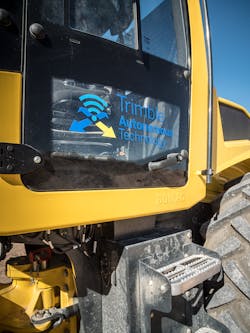Even though many are back to work and some of you never stopped, the impact of the coronavirus pandemic on construction will likely be felt for many months—and possibly years—to come.
Beyond the canceled and delayed projects due to lost funding, many contractors have had to adjust conventional operational practices that include a reduction in work crews and limited face-to-face interaction. Those shifts require more virtual connections—both for people and machines.
The technology is certainly available. The ability to remotely control equipment or connect to what is happening in the cab is good business practice and the future of construction. In the past, many of these tools have been considered nice to have, but, in the new norm, these solutions are fast becoming a business imperative. Here’s a look at a few of the top technologies gaining extra attention in today’s construction space.
Remote and Responsive
Earthworks and site prep contractors are no strangers to advanced tools, techniques, and machines that simplify or improve processes. Today's earthmoving machines and road-paving systems incorporate telematics, machine-guidance and machine-control systems (2D and 3D), and/or on-board wireless connections to transmit site data with ease and speed from the job site to the office.
According to Mordor Intelligence's Construction Machinery Market – Growth, Trends, and Forecast (2020–2025), the construction machinery market is expected to grow by a compound annual rate of 7.5% between 2020–2025. More significantly, digitalization, connectivity, and automation of these machines are making a substantial impact on construction projects. The report notes that equipment rental companies are investing in technologies such as telematics and machine control to meet the growing demand for advanced construction machinery.
For instance, R.B. Jergens, a mid-size, family-owned environmental and heavy civil contractor based in Vandalia, OH, estimates that surveyor and field crews saved three days each on a recent job—at least 40 hours—by using excavator automatics to dig to a prescribed design elevation. David Reynolds, surveying manager with R.B. Jergens, notes that machine control eliminates the need for a grade checker in many cases. “We've been able to reallocate resources more effectively and increase our productivity anywhere from 50 to 100% on certain job tasks, so we’re leaner and more profitable.”
Now those investments in productivity will also help guide the post-pandemic future that requires considerably more social distancing.
Britton Lawson, Director of Construction Technology at specialty contractor Veit & Company, Inc., confirmed: “In our current world, collaborative and job tracking software is eliminating the need to hand paper off to someone that would likely encroach on the social distance recommendations. All of our job tracking, plans, safety, and project documentation are digital, so there is no need for a weekly visit to all of our sites to pick up or hand off updated project documentation.” Headquartered in Rogers, MN, Veit is one of the top site prep and civil construction firms in the upper Midwest.
Many of the same solutions that enable contractors to work from a safer social distance also make job sites safer, overall. “The implementation of systems in excavators has allowed the excavator operator to do the majority of his job without a laborer on the ground,” said Mike Jouben, general manager at SITECH Northeast. “They have a live feed in the cab of what they are trying to build. The systems that are in excavators and dozers eliminate the number of people huddled together on the ground.”
SITECH customers are also taking a closer look at coordinating data from different equipment manufacturers, which allows operators to exchange 3D site data on a job. With systems that work together, operators will have a complete view of site productivity including materials quantity movement, volume, and compaction data, in real-time, from the cab.
Risk and Resolution
Digital collaboration is also taking on greater importance as the one sure way for project managers and foremen to see and share actionable data, monitor job activities, and troubleshoot problems without physical interaction.
Veit’s Lawson says his colleagues are seeing real value during the pandemic with remote assistance and remote file transfer. "These tools are limiting our need to be onsite to troubleshoot, train, and transfer files," he adds. "We have used remote technology for years in our day-to-day activities, but the process/functionality is showing its benefit in this new normal."
He also notes the expanded use of video conferencing to host pre-construction meetings instead of the more conventional method of pulling field staff into the office. “Now, field crews can be part of a meeting while still in the field. Video conferencing will continue to be a great way to connect our team no matter the region, location, or project schedule,” adds Lawson.
To this end, contractors such as Veit are relying on Trimble WorksManager software to send 3D models to machines and survey crews, and manage field-based devices from the office. Through this portal, the firm’s survey team can remotely connect to any of its field devices.
Colorado-based heavy/highway contractor Zak Dirt is realizing similar benefits. Company leadership says digital data, both on the ground and in the air, and cloud collaboration are vital to helping keep complex and dangerous jobs, such as the repair and replacement of flood-damaged mountain roads, safe and on budget and schedule. The firm's crews use machine control on motor graders, dozers, and excavators to complete earthwork to specs, and then look to sensor-enabled drones to capture progress.
Angelo Mancina, Zak Dirt’s corporate treasurer, who also handles GPS surveying, says, “With drone data, the engineer can see cross-sections compared to the design, and they can measure and revise previously blasted slopes as needed.”
Zak Dirt has found that the accessibility of the drone data has started a chain reaction of new or more in-depth ways of using worksite data to track progress, quantities, logistics, and more on this project and future projects.
In a case of exceptional timing, Integrated Sustainability, a Calgary-based engineering, environmental, and construction firm, is uniquely equipped to deal with current social distancing parameters. Over the last year, the firm reshaped its construction processes to include embedded sensors, GPS technology, construction management software, drones, and geomatics software. Since implementation, the company has found that they can get real-time status reporting and paint a much clearer picture of building progress, operational workflow, and material performance. Gary Smolik, Lead Construction Manager at Integrated Sustainability, comments, “When I was able to increase my production, reduce my costs, and maintain and accelerate the schedule, there’s not a job out there now that I’m not willing to go after as long as I have the technology to support me.”
Industry watchers expect to see even more investment in construction collaboration solutions that seamlessly connect contractors and facilitate improved management of assets.
Educational Touchpoint
As the level of technology-enabled functionality on excavators and other site work equipment increases, so does the need for education and workflow transformation. In the post-pandemic world, training on these sophisticated machines will also take on a new look and feel.
When asked about machine operation training, SITECH’s Jouben says, "In the past, we would go through the equipment that a client purchased in a group by pushing buttons on a screen and walking them through the technology."
Typical training sessions necessitated regular start and stop interactions in close proximity. “We used to hop up on the side of the machine to give the operator some instructions and then he’d proceed with a task and stop again when he had another question,” adds Jouben. “Now, the traditional way of training someone where we are shoulder-to-shoulder looking at the same device is not conducive to social distancing. Instead, we can do it all remotely.”
Today, Jouben might install a Wi-Fi-enabled video camera in the cab of the machine. "They can ask and we can answer questions remotely through audio, and we can see what they are doing and talk to them remotely," he says. "The continuity of production stays consistent, and we can instruct throughout the day without interrupting productivity. And I think the learning is more effective because the operator is absorbing through an independent hands-on application so there is greater retention."
Jouben says his team will continue to use the processes they have developed in the future because it's more efficient and because they're seeing that it results in better learning than the old way.
Of course, construction equipment simulators are also an increasingly familiar method for helping operators explore and expand machine control skills on excavators, dozers, motor graders, haulers, and scrapers in a variety of scenarios.
If the full simulator is not available, there are also plenty of apps from manufacturers and developers to learn basic or advanced skills. These apps make it easy to learn and practice machine control features and functionality from home.
Instruct-by-video modules can also help experienced operators practice advanced skills, from lane guidance to cleaning trenches and pipe placement. Keeping skills sharp through virtual reality (VR) training will ensure your team is ready to move forward with productive and safe operations when business returns to normal. Currently, much of the VR technology being developed for the construction industry is for training purposes. By training workers in a virtual world, they can acquire the skills necessary to do their jobs in a safe environment.
Scaled to Fit
Recent events have also highlighted the need for scalable investments. Few companies have the time or resources to adopt all of the latest and greatest solutions—but a path to upgrade should be an option. It’s important that contractors can both carefully manage cash flow and also deliver projects on time and within budget.
Industry response to the new Trimble Platform as a Service (TPaaS), for example, has been strong. This program gives contractors the ability to purchase Trimble technology solutions and continually upgrade them with the latest versions for a fixed monthly price. This will be the way of the future for construction technology because it allows construction business owners to use Trimble construction technology for a low monthly payment.
TPaaS gives contractors the ability to modernize large construction fleets and inventories without significant initial investment and the assurance that their technology will be continually updated with the latest innovations. This approach allows contractors to use their capital to run the business as well as predictably manage technology expenses.

